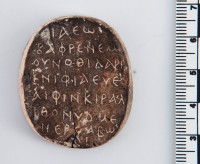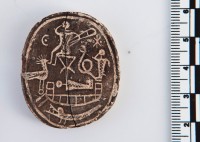 A 1,500-year-old amulet inscribed with a 59-letter Greek phrase that reads the same backwards and forwards has been found in Cyprus. Archaeologists from the Paphos Agora Project discovered it in 2011 during the first season of excavations of the ancient agora of Neo Paphos. Neo Paphos, a harbour city on the southwest coast, was the capital of Cyprus in the late Hellenistic, Roman and Byzantine periods.
A 1,500-year-old amulet inscribed with a 59-letter Greek phrase that reads the same backwards and forwards has been found in Cyprus. Archaeologists from the Paphos Agora Project discovered it in 2011 during the first season of excavations of the ancient agora of Neo Paphos. Neo Paphos, a harbour city on the southwest coast, was the capital of Cyprus in the late Hellenistic, Roman and Byzantine periods.
The inscription reads:
ΒΑΦΡΕΝΕΜ
ΟΥΝΟΘΙΛΑΡΙ
ΚΝΙΦΙΑΕΥΕ
ΑΙΦΙΝΚΙΡΑΛ
ΙΘΟΝΥΟΜΕ
ΝΕΡΦΑΒW
ΕΑΙ
which translates to “Iahweh is the bearer of the secret name, the lion of Re secure in his shrine.”
Renown for its temples to Aphrodite (she made landfall at Paphos after her birth from the sea), Neo Paphos also had an early connection to Christianity. It features in the Acts of the Apostles 13:6-13 wherein Paul curses a false prophet with a year of blindness for trying to lead the Roman proconsul Lucius Sergius Paullus astray. Amazed by the power of God working through Paul, Lucius Sergius converts to Christianity. After the death of Theodosius I, the last emperor to rule both the East and West halves of the Roman Empire, in 395 A.D., Cyprus became part of the Eastern Empire, and although the traditional Greek polytheistic religion was actively suppressed by the authorities, a strong culture of Hellenistic Christianity developed.
 The amulet is evidence of how long polytheistic beliefs survived on Cyprus and how Christianity was integrated into traditional religious practices, a religious syncretism that would endure for centuries after Theodosius made Christianity the state religion. It 1.4 inches wide by 1.6 inches long and is made of mud clay. One side of the amulet is crudely engraved with images of Egyptian deities. At the bottom is a crocodile with open jaws. Above him is a mummy wrapped in bandages (probably meant to be the god Osiris) lying on a boat. To the left of the mummy is a bird (its comb suggests it may be a rooster), to the right is a snake and what archaeologists have identified as a dog-headed figure or cynocephalus even though the head is just a rudimentary circle.
The amulet is evidence of how long polytheistic beliefs survived on Cyprus and how Christianity was integrated into traditional religious practices, a religious syncretism that would endure for centuries after Theodosius made Christianity the state religion. It 1.4 inches wide by 1.6 inches long and is made of mud clay. One side of the amulet is crudely engraved with images of Egyptian deities. At the bottom is a crocodile with open jaws. Above him is a mummy wrapped in bandages (probably meant to be the god Osiris) lying on a boat. To the left of the mummy is a bird (its comb suggests it may be a rooster), to the right is a snake and what archaeologists have identified as a dog-headed figure or cynocephalus even though the head is just a rudimentary circle.
Above the mummy is a depiction of Harpocrates, a Hellenized version of the Egyptian child god Horus, deity of silence and secrecy, sitting on a cross-frame stool and holding a large scepter in his left hand. He is recognizable because of the characteristic position of his right hand raised to his mouth, a depiction of the hieroglyphic for “child” which the Greeks misunderstood as a “shh” gesture. Horus the Child/Harpocrates was often depicted with a dog, which is how, I believe, the archaeologists identified the cynocephalus as such, but there are incongruities with the design that suggest the carver was confused about the religious iconography.
“It must be stated that the depiction is fairly unskilled and schematic. It is iconographically based on Egyptian sources, but these sources were not fully understood by the creator of the amulet,” adoration,” [Joachim Śliwa, a professor at the Institute of Archaeology at Jagiellonian University in Kraków, Poland,] wrote in the journal [Studies in Ancient Art and Civilization] article.
For instance, rather than sitting on a stool, Harpocrates should be sitting on a lotus flower, with legs drawn up, Śliwa said. Additionally, the dog-headed cynocephalus should not be mimicking Harpocrates. In “the classic version, the cynocephalus faces Harpocrates with paws raised in adoration,” Śliwa wrote.”We can find no justification for the cynocephalus’s gesture of raising its right paw to its lips in a manner similar to Harpocrates.”
Even stranger is the fact that Harpocrates and the cynocephalus have crisscrossing lines on their bodies, which suggest the ancient artist thought these figures should be mummified along with Osiris. While the cynocephalus can be shown with mummy bandages, Harpocrates is not supposed to have them. Mummy bandages have “no justification in the case of Harpocrates,” Śliwa wrote.
It makes sense that after more than a century of official Christianity, with all the temples, schools, libraries, etc. where one might learn the standard polytheism destroyed or redirected towards Christianity, people exploring traditional religious imagery and language would wind up with jumbled details.